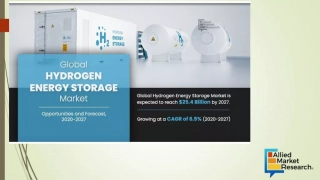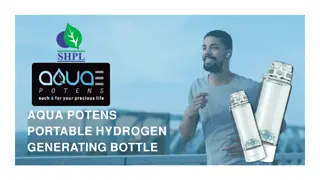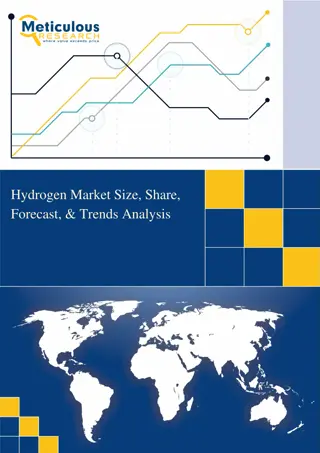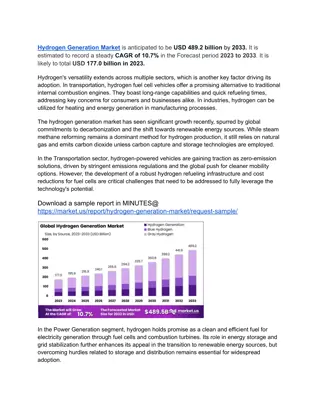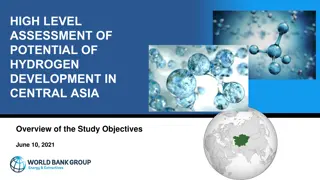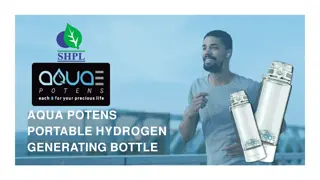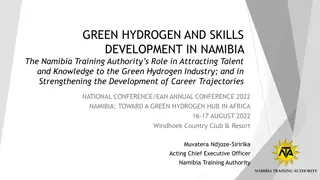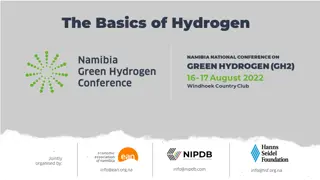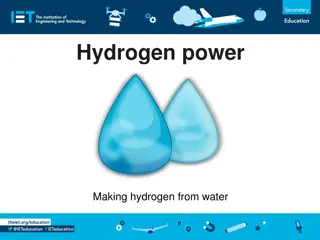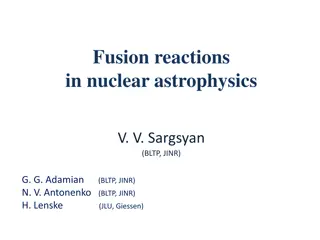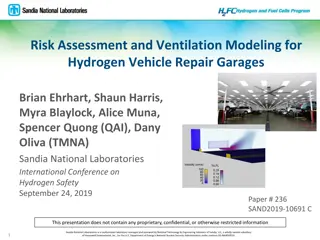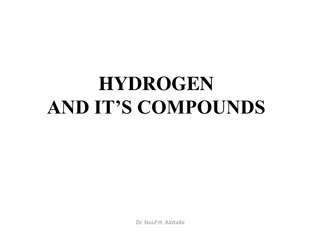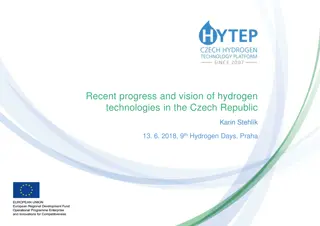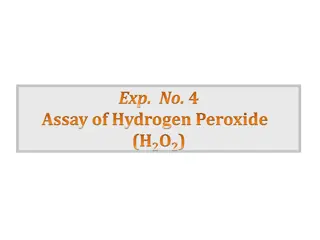Insights into Hydrogen: Properties, Reactions, and Applications
Discover the key properties, preparation methods, and isotopic composition of hydrogen. From its role as the most abundant element in the universe to its use as a powerful reducing agent and industrial reagent, explore the diverse characteristics and applications of this versatile element. Learn about its unique bonding capabilities, isotopic variations, and industrial production processes, shedding light on the essential role of hydrogen in various fields.
Download Presentation

Please find below an Image/Link to download the presentation.
The content on the website is provided AS IS for your information and personal use only. It may not be sold, licensed, or shared on other websites without obtaining consent from the author. Download presentation by click this link. If you encounter any issues during the download, it is possible that the publisher has removed the file from their server.
E N D
Presentation Transcript
Hydrogen Preparation, Properties and Reactions Background: Hydrogen is found in group one, period one in the periodic table. It has a simple atomic structure Is the most abundant element in the universe The stable form is dihydrogen i.e. H2 It is found in oceans, minerals and all forms of life It also occurs naturally as a product of fermentation and a byproduct of ammonia synthesis Ground State configuration is 1s1 It has a richly varied chemical properties Is a strong lewis base (H-) and a strong Lewis Acid (H+) It bonds with nearly every other element 3
Properties of Hydrogen ) Its Ionization energy is far higher than those of the other Group 1 elements Is not a metal Electron Affinity of hydrogen is far lower than that of any of the elements of Group 7 The intermolecular forces between H2 molecules are week, at 1atm the gas condenses to a liquid only when cooled to 20k H2 molecule has a high bond enthalpy (436KJmol-1) It has a short bond length (7pm) It has a high bond strength so that the H2 is an inert molecule, as such reactions of H2 does not occur readily Hydrogen is an excellent fuel for large rockets on account of its high specific enthalpy (Standard enthalpy of combustion divided by the mass) 4
Properties of Hydrogen Hydrogen can gain an electron in a chemical reaction to achieve a noble gas configuration, i.e. Hydride ion, H- which is a powerful reducing agent Hydrides may act as ligands in bonding to metals e.g. ReH92- Bonding to hydrogen atoms is essentially covalent Hydrogen ion (H+) is common, but in aqueous solution, a more correct description is H3O+ (aq) Molecular hydrogen is also an important reagent in the industrial hydrogenation of unsaturated organic molecules Hydrogen has three isotopes, i.e. Protium, (Normal hydrogen H) Deuterium ( Heavy hydrogen D) and Tritium ( Another heavy form T) 5
Table 1 Properties of Hydrogen Isotope Abundanc e (%) Atomic Mass Melting Point (K) Boiling Point (K) Critical Temperatu re (K)a Enthapy of Dissociation(K J mol-1 at 25oc) Protium (1H), H 99.985 1.00782 5 13.957 20.30 33.19 435.88 Deuteriu m (2H), D 0.015 2.014102 18.73 23.67 38.35 443.35 10-16 Tritium (3H), T 3.01604 9 20.62 25.04 40.6 446.9 6
Preparation of Hydrogen Industrially, most H2 is produced from natural gas by using steam reforming ( the catalyzed reaction of H2O As Steam and hydrocarbons typically methane from natural gas It is also produced industrially by other methods such as coal gasification and thermally assisted electrolysis At a small scale it can be produced from the laboratory from electropositive elements and mineral acids or by hydrolysis of saline hydrides, or by electrolysis 7
Preparation of Hydrogen by Electrolysis Electrolytic hydrogen is the purest commercially available grade of hydrogen and is made by the electrolysis of water. 2H2O ==> 2 H2(g) + O2(g nickel electrodes are used with warm saturated barium hydroxide solution. The prepared gas is passed over hot platinum gauze to purify it The gas is then dried by passing it over potassium hydroxide pellets and pure redistilled powdered phosphorus pentoxide. 8
Preparation of Hydrogen by the Action of Metals The alkali metals, lithium, sodium, and potassium react violently with water at the ordinary temperature, yielding hydrogen. 2Li + 2 H2O ==> H2 + 2 LiOH Calcium reacts with water more slowly unless the water is hot, when the action is more vigorous Ca + 2 H2O ==> H2 + Ca(OH)2 9
Preparation of Hydrogen by Decomposition of Water Cold water is decomposed by amalgamated aluminium (i.e. an alloy of aluminium and mercury which is made by rubbing aluminium foil with damp mercuric chloride). 2 Al + 6 H2O ==> 2 Al(OH)3 + 3 H2 Hot water is decomposed by zinc-Copper couple (i.e. solid granules of zinc covered by a surface layer of copper which made by pouring a solution of copper sulphate over granulated zinc). Zn + 2H2O ==> Zn(OH)2 + H2 10
Preparation of Hydrogen by Decomposition of Water Boiling water is slowly decomposed by magnesium power. Steam is decomposed when passed over heated magnesium, zinc, and iron. Mg + 2H2O ==> Mg(OH)2 + H2 The last reaction, (i.e. the action of iron on steam) is reversible, depending on the experimental conditions. 3 Fe + H2O <==> Fe3O4 + 4H2 Mg + H2O ==> MgO + H2 Zn + H2O ==> ZnO + H2 11
Preparation of Hydrogen from Action of Acids Hydrogen is prepared in the laboratory by the action of acids on metals. Dilute sulphuric acid containing 1 volume of concentrated acid to 5 volumes of water, or dilute hydrochloric acid containing 1 volume of concentrated acid to 4 volumes of water, is added to granulated zinc. Zinc sulphate or zinc chloride is formed in solution and the hydrogen that is evolved is collected over water in a trough. Zn + H2SO4 ==> ZnSO4 + H2 Zn + 2 HCl ==> ZnCl2 + H2 Since hydrogen is very much lighter than air it may also be collected by upward displacement. 12
Industrial Manufacture of Hydrogen Pure hydrogen is manufactured industrially by the steam reforming of natural gas, and by the electrolysis Of water. The manufacture of hydrogen on an industrial scale involves the reaction between steam and iron. Spongy iron from the reduction of spathic iron ore (ferrous carbonate) is heated to redness and steam passed over it. 3 Fe + 4 H2O ==> Fe3O4 + 4 H2 The hot ferrosoferric oxide, Fe3O4, is then reduced with water gas: Fe2O4 + 4 H2 ==> 3 Fe + 4 H2O Fe2O4 + 4CO ==> 3 Fe + 4 CO2 Water gas is made by passing steam over red hot carbon and it consists of a mixture of carbon monoxide and hydrogen, with a smaller amount of carbon dioxide: 13
Industrial Manufacture of Hydrogen Commercially Hydrogen can be prepared by cracking petroleum hydrocarbons with solid catalysts C2H6==> C2H4 + H2 Also can be prepared by steam reforming of natural gas using catalyst CH4 + H2O ==> CO + 3H2 14
Reactions of Hydrogen Hydrogen is quite stable that it is an inert molecule, but it reacts very rapidly under special conditions such as:- A) Homolytic dissociation into H atoms using metal surfaces H2 + Pt ==> Pt-H (adsorption of H ions on Pt surfaces) B) heterolytic dissociation into H+ and H- ( metal ion for coordination) H2 + Zn-O-Zn-O- ==> metal coordinated ions C) Initiation of a radical chain reaction H2 x ==>XH. + H. O2==> HOO. e.g Initiation by heat or light Br2 ==> Br. + Br. Propagation Br. + H2 ==> HBr + H. Termination H. + H. ==> H2 Br. + Br. ==> Br2 H. + Br. ==> BrH 15
Introduction to the s block elements - Group 1 Alkali Metals and Group 2 Alkaline Earth Metals Gp1 1H 3Li lithium 11Na sodium 19K potassium 37Rb rubidium 55Cs caesium 87Fr francium 16
Introduction to the s block elements - Group 1 Alkali Metals and Group 2 Alkaline Earth Metals Gp2 4Be beryllium 12Mg magnesium 20Ca calcium 38Sr strontium 56Ba barium 88Ra radium outer electrons: Group 1 ns1and Group 2 ns2 17
Introduction to the s block elements - Group 1 Alkali Metals and Group 2 Alkaline Earth Metals The first two vertical columns of the Periodic Table, i.e. Groups 1 and 2, are called the s block metals, because they only have 1 or 2 electrons in their outer shell. These outer electrons are of an s orbital type (s sub shell or sub quantum level) and the chemistry of the metals, with their relatively low ionisation energies, is dominated by the loss of these s electrons to form a cation and also accounts for their generally high chemical reactivity 18
Electronic Structures of 1A H has its only electron in the 1s orbital - 1s1, Li has an electronic structure of 1s22s1. Na has an electronic structure of 1s22s22p63s1 K has an electronic structure of 1s22s22p63s23p64s1 Rb has an electronic structure of 1s22s22p63s23p64s23d10 4p65s1 Cs 1s2, 2s22p6, 3s2 3p6, 4S2 3d10 4P6, 5s2 4d10 5p6, 6s1 Fr 1S2, 2S2 2P6, 3S23P6, 4S23d10 4P6, 5S2 4d10 5P6, 6S2 4f14 5d10 6p6, 7S1 20
Group Ia and Group IIa The outer s1electron loss by the Group 1 Alkali Metals gives the M+ion, and, The outer s2electrons lost by the Group 2 Alkaline Earth Metals forms the M2+ion, And in each case the cation has a residual very stable noble gas core of electrons. 21
Group Ia and Group IIa The only chemically stable oxidation states are +1 for Group 1 metals and +2 for Group 2 elements, This is because of the ease of loss of the outer S electrons and the difficulty in removing the next one due to high ionisation energies required The relative ease of delocalising the outer 1/2 electrons in the metal lattice makes them good conductors of heat and electricity The low ionisation energies and low electronegativity means that when combined with non metals, most compounds of the Group 1 2 elements tend to be ionic in nature. 22
Group Ia and Group Ia Properties\Na me Lithium Sodium Potassiu m Rubidium Caesium Francium melting point/oC 181 98 64 39 29 27 boiling point/oC 1347 883 774 688 679 677 density/gcm 3 0.53 0.97 0.86 1.48 1.87 > 1.87 1st IE/kJmol 1 513 496 419 403 376 400 2nd IE/kJmol 1 7298 4562 3051 2632 2420 2100 atomic metallic radius/pm 152 186 231 244 262 270 M+ionic radius/pm 78 98 133 149 165 180 Electronegati vity 0.98 0.93 0.82 0.82 0.79 0.70 23
Group Ia and IIa Elements /properti es Li Na K Rb Cs Fr Electrode potential M/M+ -3.04v -2.71v -2.92v -2.92v -2.92v -2.92v electron configuration 2,1 2,8,1 2,8,8,1 2,8,18,8,1 2,8,18,18,8 ,1 2,8,18,32,1 8,8,1 Electron (He) 2s1 (Ne)3s1 (Ar)4s1 (Kr)5s1 (Xe)6s1 (Rn)7s1 Configura tion 24
Group Ia and IIa Typical metals in some ways e.g. silvery grey lustrous solids, very good conductors of heat and electricity, relatively high boiling points. When freshly cut they are quite shiny, but they rapidly tarnish by reaction with oxygen to form an oxide layer, which is why they are stored under oil The 1st ionisation energies are the lowest of any group of elements, but note the jump up to a very high 2nd ionisation energy. 25
Group Ia and IIa The very high 2nd ionization energy is due to removing an electron from an electronically very stable noble gas inner core of electrons Group IIa are typical metals, silvery grey lustrous solids, relatively high melting and boiling points, good conductors of heat and electricity. The first two ionisation energies are relatively low but there is quite a jump to the 3rd ionisation energy The very high 3rd ionization energy is due to removing an electron from an electronically very stable noble gas inner core of electrons 26
Group IIa Compared to adjacent Group 1 metal on same period: The melting and boiling points are higher, and they are harder, stronger and more dense than the adjacent Group 1 metal on the same period. This is because their are two delocalised electrons per ion in the crystal lattice giving an overall stronger electrical attraction with the more highly charged M2+ions. Chemically very similar e.g. form mainly ionic compounds but different formulae and less reactive because the 1st ionisation energies are higher (due to extra nuclear charge) and a 2nd ionisation energy input to form the stable M2+ion. Oxidation state or oxidation number is always +2 in Group 2 27
Group IIa The two outer s electrons are readily lost. The 3rd, and subsequent ionisation energies are far too high to form chemically stable cations of 3+ etc. i.e. the energy required will not be compensated by ionic bond formation. The stable Group 2 cation has electron configuration of noble gas, e.g. the calcium atom, Ca, is 2,8,8,2 or 1s22s22p63s23p64s2or [Ar]4s2 so the calcium ion, Ca2+, is 2,8,8 or 1s22s22p63s23p6or [Ar] 28
General Trends down groups 1 & 2 with increasing atomic number and formula patterns The 1st ionisation energy (IE) or 2nd etc. decrease: (important to link to reactivity trend) 29
Group IIa REACTIVITY TREND THEORY relate to atomic radius and ionisation energy The metal gets more reactive down the group because... When an alkali metal atom reacts, it loses an electron to form a singly positively charged ion e.g. Na ==> Na++ e As you go down the group from one element down to the next the atomic radius gets bigger due to an extra filled electron shell. The outer electron is further and further from the nucleus and is also shielded by the extra full electron shell of negative charge. Therefore the outer electron is less and less strongly held by the positive nucleus. This combination of factors means the outer electron is more easily lost, the M+ion more easily formed, and so the element is more reactive as you go down the group The reactivity argument mainly comes down to increasingly lower ionisation energy down the group and a similar argument applies to the Gp 2 metals, but two electrons are removed to form the cation. The reaction of a group 1/2 metal with oxygen, water or halogens gets more vigorous as you descend the group. 30
Group I a and IIa The Electronegativity tends to decrease: 31
Group Ia and IIa The electronegativity values are the lowest in the last element down the group They get lower because the effective nuclear attractive force on the outer electron charge decreases down the group. You can explain it along the lines of the decreasing 1st IE argument , that means weaker attraction of electron charge' 32
Group IIIa There are five chemical elements in group IIIA of the periodic table: These are:- Boron B, Aluminum Al, Gallium Ga, Indium In and Thallium Tl. 33
Group IIIa The atoms of these elements have the following configurations: 5B 1s22s22p1 [He]2s22p1 13Al 1s22s22p63s23p1 [Ne]3s23p1 31Ga 1s22s22p63s23p63d104s24p1 [Ar] 4s24p1 49In 1s22s22p63s23p63d104s24p64d105s25p1 [Kr] 5s25p1 81Tl 1s22s22p63s23p63d104s24p64d104f145s25p65d106s26p1 [Xe]6s26p1 34
Group IIIa: Group Trend Metallic character increases down the group The first member of the group boron, is essentially nonmetallic, whereas the properties of members of the group are distinctly metallic The elements have variation from predominantly covalent to ionic bonding in their compounds Atomic radius increase down the group Ionization energy decreases down the group The valence electron configuration is ns2 np1 They have +3 oxidation state in their compounds but heavier members also use +1 oxidation state in their compounds e.g. Tl, +1 0xidation state becomes more stable down the group 35
Properties of the Group IIIa Elements Properties Boron Aluminum Gallium Indium Thallium Melting point, C 2076 660 30 157 304 Boiling point, C 3927 2519 2204 2072 1473 Density, g/cm3 2.46 2.7 5.9 7.3 11.85 Electronega tivity 2.0 1.6 1.8 1.7 1.6 Covalent radius, 0.91 1.43 1.39 1.66 1.71 Ionic radius, 0.20 0.57 0.62 0.92 1.05 36
Chemistry of Boron and its compounds Boron is the first element in group III In many of its properties it differs from the next element in the group, aluminum, which is a metal It is a very poor conductor of electricity therefore it is best regarded as a semimetal, like silicon than metallic Boron shows trivalency in its compounds 37
Chemistry of Boron and its compounds It is difficult to get B3+, therefore, boron forms tricovalent compounds Boron shows common oxidation state of +3 in majority of its compounds However boron shows also an oxidation state of 3 in the metal borides, e.g., in Mg3B2 Boron forms oxide B2O3when heated in oxygen atmosphere at high temperature: 4B + 3O2 ==> 2B2O3(Boron oxide or Boric anhydride). 38
Chemistry of Boron and its Compounds Boron can form trichloride either by passing chlorine over the heated boron or by passing chlorine over the heated mixture of its oxide and charcoal 2B + 3Cl2 ==> 2BCl3; B2O3+ 3C + 3Cl2 ==> 2BCl3+ 3CO. BCl3is hydrolyzed by water: BCl3+ 3H2O H3BO3+ 3HCl. 39
Chemistry of Boron and its Compounds Boron forms nitride BN when heated in the atmosphere of nitrogen or ammonia and sulfide B2S3when heated with sulfur: 2B + N2 ==> 2BN; 2B + 2NH3 ==> 2BN + 3H2; 2B + 3S ==> B2S3 The nitride and sulfide of Boron undergo hydrolysis with steam to form Boric acid BN + 3H2O H3BO3+ NH3; Boric acid B2S3+ 6H2O 2H3BO3+ 3H2S. 40
Chemical Properties of Boron and its Compounds Boron reacts with steam when heated liberating hydrogen: 2B + 3H2O B2O3+ 3H2. Its also react with H2SO4and evolves sulfur dioxide, SO2: 2B + 3H2SO4(conc.) 2H3BO3+ 3SO2 . It can also dissolve in alkalies and evolve hydrogen 2B + 6NaOH 2Na3BO3+ 3H2 . Producing sodium orthoborate Boron acts as powerful reducing agent: 4B + 3CO2 2B2O3+ 3C; 4B + 3SiO2 2B2O3+ 3Si. 41
Compounds of Boron BORANES: Compounds of Hydrogen and Boron are known as Boranes e.g. B2H6, B4H10, B5H9, and B10H14 Their formulas are not what we expect like +3 oxidation state of Boron 42
Boranes The unusual and unexpected feature of this structure is that there are two hydrogen atoms, calledbridging hydrogens, shared between the two borons. However, there are not enough electrons for each of the lines shown in the structure to represent an electron pair. Each atom of boron contributes 3 electrons and each atom of hydrogen 1 electron, making a total of 12 electrons, or six pairs for the molecule. Thus there can be a maximum of only six ordinary covalent bonds, whereas the structure appears to have eight bonds. Because B2H6has too few electrons for all the atoms to be held together by normal electron pair bonds between two nuclei, it is often described as an electron-deficient molecule. The bonding in diborane is best described as involving two three-center bonds, in which one electron pair holds together three rather than two nuclei. Each boron atom is surrounded by four electron pairs, which have the expected tetrahedral arrangement. But two of these electron pairs form three-center bonds in which one electron pair holds together two boron nuclei and a hydrogen nucleus 43
BORON HALIDES The boron halides are typical covalent nonmetal halides Boron trifluoride, BF3, and boron trichloride, BCl3, are gases at room temperature; BBr3is a liquid, and BI3is a solid These halides all consist of molecules with the expected AX3planar triangular structure Although the electronegativity difference between boron and fluorine is 2.1, boron trifluoride is a covalent molecular compound with polar B F bonds rather than an ionic crystal containing B3+and F ions 44
Boron Halides Because of the presence of the vacant 2p orbital on the boron atom in the boron halides, they are rather reactive compounds For example, BF3reacts with an F ion to form BF4 in which the valence shell of boron is completed BF3+ NaF NaBF4 The boron halides react with water forming boric acid and the hydrogen halides. For example, BCl3+ 3H2O H3BO3+ 3HCl 45
BORIC ACID AND BORATES Boric acid and the borates are among the simplest and most important of the boron compounds. Boric acid, B(OH)3, is a stable, colorless crystalline compound that forms thin, plate like crystals. It consists of planar molecules with an equilateral triangular AHal3geometry around boron. The molecules are held together in flat sheets by hydrogen bonds: 46
BORIC ACID AND BORATES Boric acid is a very weak monoprotic acid (Ka= 6.0 10 10). It ionizes in water in an unusual way. Instead of donating one of its hydrogen atoms to a water molecule; it removes an OH-from a water molecule, leaving an H+ion, which combines with another water molecule to give an H3O+ion: H3BO3+ 2H2O B(OH)4 + H3O+. 48
Group IVa Group elements are Carbon ( C ) Silicon ( Si ) Germanium ( Ge ) Tin ( Sn ) Lead ( Pb ) Atomic Number 6 14 32 50 82 Very diverse in chemical and physical properties e.g. C nonmetallic, while Sn and Pb are metals. These elements in this group are very important in nature 49
Group IVa The atoms of these elements have the following configurations: 6C 1s22s22p2[He]2s22p2 14Si 1s22s22p63s23p2 [Ne]3s23p2 32Ge 1s22s22p63s23p63d104s24p2[Ar] 4s24p2 50Sn 1s22s22p63s23p63d104s24p64d105s25p2 [Kr] 5s25p2 82Pb 1s22s22p63s23p63d104s24p64d104f145s25p65d106s26p2[Xe]6s26 p2 50


